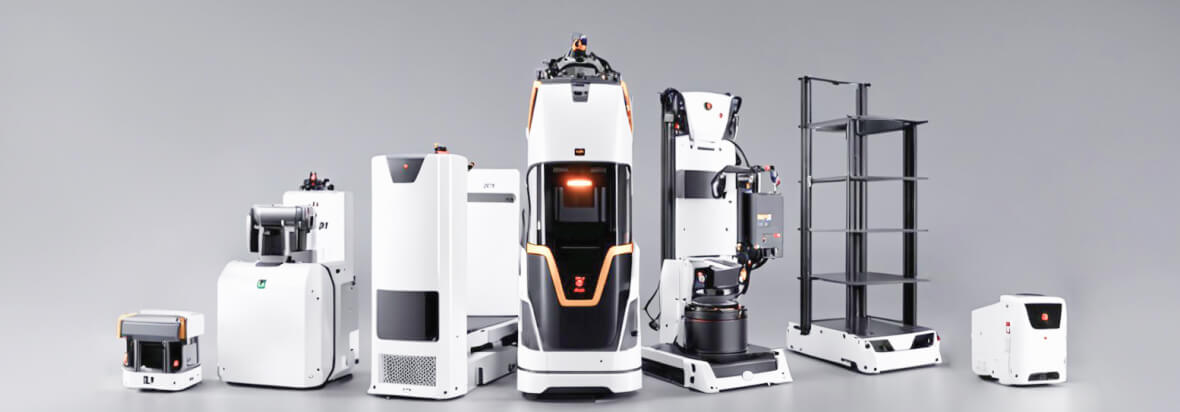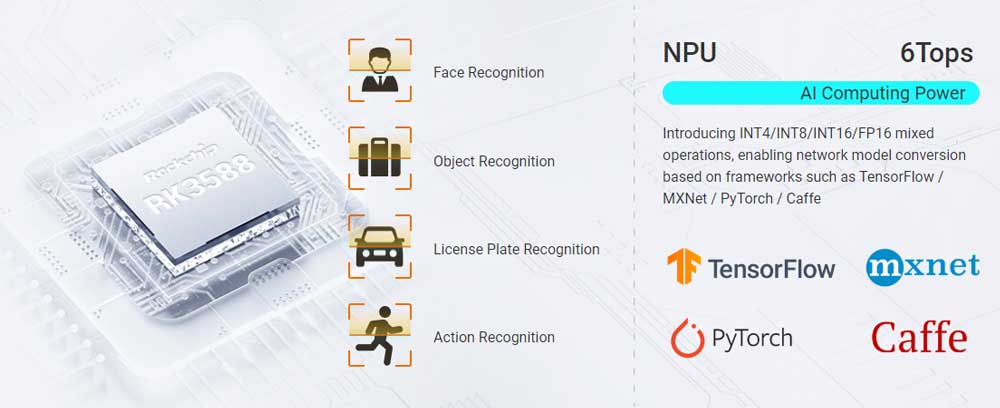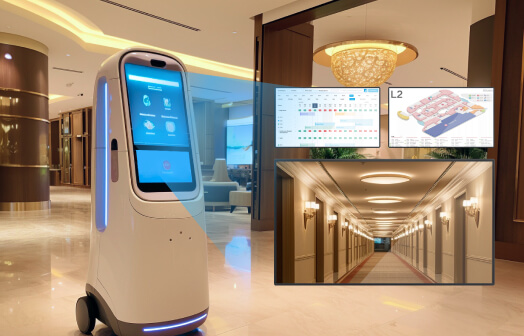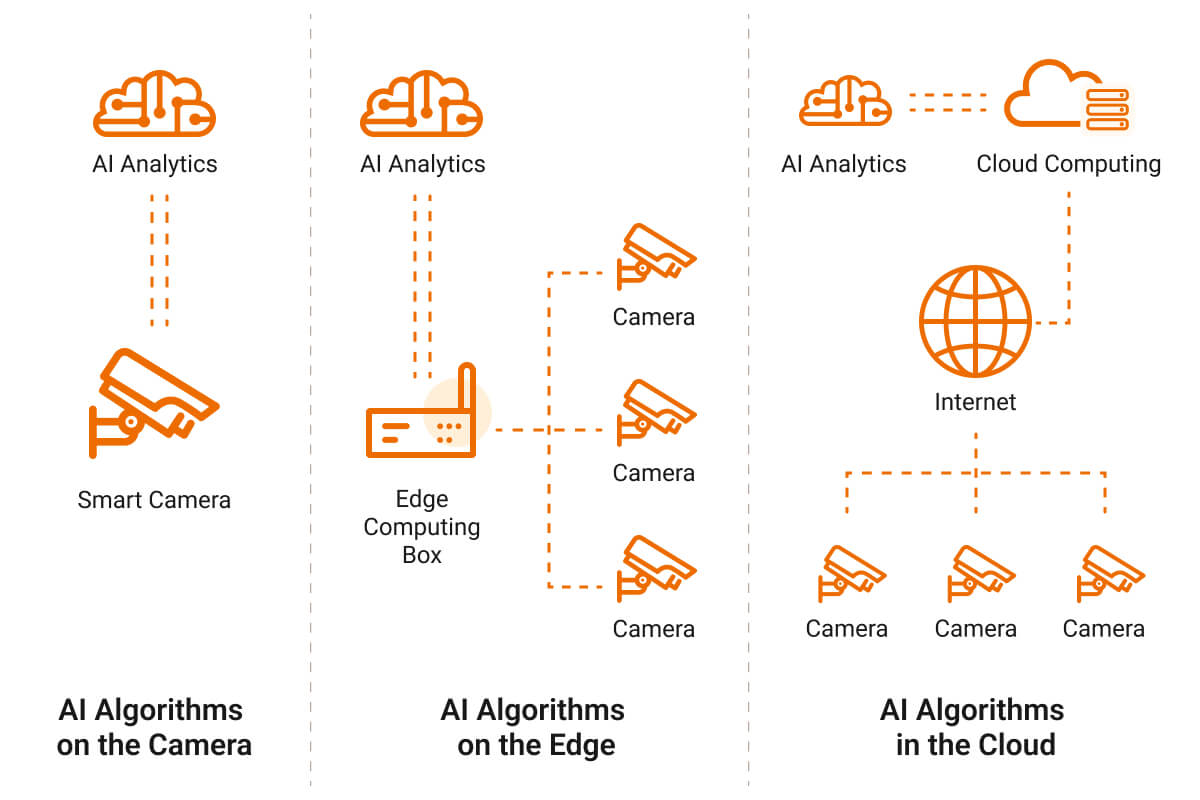A mobile robot is a self-driven machine powered by advanced AIoT hardware and sophisticated software programming. Utilizing artificial intelligence, IoT, and wireless detection, these robots can identify their surroundings and navigate their environment autonomously.
Introduction to Autonomous Mobile Robots
Autonomous mobile robots like AGV or AMR are designed to move independently, reacting to input data from their environment. They are a sophisticated blend of AIoT hardware and software. Equipped with sensors like cameras, LiDAR, and ultrasonic sensors, AMRs perceive their surroundings, creating a digital map of their environment. Advanced algorithms enable AMRs to process sensory data, make real-time decisions, and plan their movements accordingly. Leveraging technologies like SLAM, AMRs can build and update maps of their environment while simultaneously determining their position within it.

Types of Mobile Robots
Mobile robots can be categorized into two main types based on their guidance systems: autonomous and non-autonomous (guided) mobile robots.
Automated Guided Vehicles (AGVs)
AGVs require some fixed paths or external guidance to navigate, such as sensors installed in their environment. These systems can be costly to deploy and complex to adjust as needs change.
Autonomous Mobile Robots (AMRs)
In contrast, AMRs possess an inherent ability to navigate and make decisions independently. They are designed to move and explore their surroundings without any external direction, and without the need for physical infrastructure.
The first general-purpose mobile robot to move around autonomously was Shakey, developed in 1970 by SRI International. Shakey could reason about its actions, allowing it to receive general commands and figure out the necessary steps to accomplish the given task. Shakey laid the groundwork for today’s sophisticated AMRs.
Resource: wikipedia
Why RK3588J SBC is the Best Autonomous Mobile Platform?
The RK3588J SBC, developed by Dusun IoT and powered by Rockchip’s flagship SoC RK3588J, is specifically designed for autonomous mobile robots. This board offers exceptional computing power, multiple interfaces, and industrial-grade quality. Dusun IoT provides a complete SDK and BSP for AMR and AGV applications, allowing autonomous mobile robot companies to focus solely on application development without needing to port low-level drivers.
An Embedded Board Specially Designed for AGV or AMR with Robust Processing Power and Industrial-Grade Standards
The RK3588J SBC features an octa-core setup with Cortex-A76 (up to 2.4GHz) and A55 CPUs (1.8GHz), and a Mali-G610 GPU. This configuration delivers excellent processing and graphics capabilities, enabling AGVs and AMRs to handle complex tasks such as real-time navigation, complex obstacle avoidance, and advanced sensor fusion
The board supports various operating systems including Linux, RTOS, and Bare-metal, as well as multi-core heterogeneous AMP system architecture. This ensures stringent real-time performance, high stability, and reliability required for AGV and AMR applications.
6 TOPS AI Computing Power for Intelligent AGVs and AMRs Applications
The RK3588J SBC is equipped with a formidable NPU capable of delivering 6 TOPS of AI computing power. This NPU is designed with a tri-core architecture and can operate independently or collaboratively to optimize performance and efficiency.
With support for multiple mixed-precision computing modes (INT4/INT8/INT16/FP16), the RK3588J can handles complex AI workloads.
By integrating with popular deep learning frameworks like TensorFlow, PyTorch, and MXNet, the RK3588J empowers developers to rapidly deploy sophisticated AI models. This translates to enhanced capabilities for AGVs and AMRs, including:
- Precise Object Detection and Recognition: Identify and classify objects in real-time for safe navigation and task execution.
- Advanced Path Planning: Optimize routes, avoid obstacles, and adapt to dynamic environments.
- Intelligent Decision Making: Enable robots to make autonomous decisions based on real-time data analysis.
- Enhanced Human-Robot Interaction: Facilitate natural language processing and facial recognition for improved user experiences.

Versatile Interface Resources for Complete Environmental Sensing and Interaction
The RK3588J SBC offers a robust suite of interfaces to ensure integration with a wide range of sensors and peripherals. This comprehensive connectivity empowers your AGV or AMR with exceptional environmental perception and interaction capabilities:
Core Interfaces: Equipped with USB, PCIe, and SATA ports, the RK3588J effortlessly accommodates high-precision sensors like LiDAR, cameras, and radar, as well as essential safety devices such as emergency stop buttons and proximity sensors.
Visual Insights: Dual HDMI ports enable external monitor connectivity, providing operators with a clear visual representation of the robot’s status, environment, and tasks.

Efficient Multimedia Processing for Delivering Stunning Visual Experience
The RK3588J’s integrated GPU and VPU support efficient 8K video decoding and smooth 4K video encoding, meeting the high standards of video monitoring and real-time video analysis in AGV and AMR applications.
In practical use, handling and transmitting high-definition video streams is crucial. The RK3588J’s multimedia processing capabilities enable real-time capture and processing of video data from cameras and other devices. It supports multiple video input and output streams, ensuring clear and smooth video signals. Efficient video compression and decompression technologies reduce storage space and bandwidth usage, lowering overall system costs.
Moreover, the RK3588J supports various video formats and encoding standards, enabling AGV and AMR robots to seamlessly integrate with existing video monitoring systems.

Rich Network Interfaces for Long-Range Communication and High-speed Data Transmission
To meet the high demands of multi-robot coordination and complex environmental operations, the RK3588J SBC integrates a variety of network interfaces to ensure robust communication and control:
- Gigabit Ethernet, Wi-Fi 6, and 5G LTE options provide high-speed data transfer for real-time operations and large data sets.
- RS485/232 and CAN interfaces enable seamless integration with legacy systems and industrial equipment.
- Built-in Lora module supports long-range communication, ideal for large-scale deployments and challenging environments.
- Onboard network transformer guarantees stable network connections, minimizing disruptions.
Industrial-Grade Quality with Low Power Consumption Design
The RK3588J SBC is built for industry and can thrive in the demanding environments. Its temperarure range is -40 to +85 °C, able to withstand extreme temperatures, vibrations, and electromagnetic interference, and keep uninterrupted operation.
One of its highlights is low power consumption. By adopting advanced low-power technology and optimized circuit design, the board achieves effective energy control while maintaining high performance. This extends the endurance of AGVs and AMRs and reduces operating costs.
In terms of thermal management, the RK3588J SBC employs efficient thermal materials and optimized thermal structures (with fan cooling system), ensuring the board’s temperature remains within a reasonable range even under long-term high-load operation. This excellent thermal performance allows AGVs and AMRs to operate stably in wide-temperature and complex electromagnetic environments, meeting the challenges of harsh conditions.

Board Diagram of AGV and AMR Robots

You May Also Be Interested In:
Benefits of Using Intelligent Autonomous Mobile Robots
One major advantage of mobile robots is their computer vision capabilities. The complex array of Coupled with the power of AI and IoT technologies, AMRs and AGVs have been essential tools for driving innovation and growth across various industries, offering a multitude of benefits:
Enhanced Situational Awareness
These robots are equipped with complex array of sensors to accurately perceive and respond to their environment in real-time, minimizing the risk of accidents and improving overall safety.
Adaptability and Flexibility
The AIoT boards and onboard intelligence systems enables AMRs and AGVs to learn and adapt to changing environments through either an uploaded blueprint or by navigating and developing a map on their own. This quick adaptation makes mobile robots to be easily redeployed for different tasks and facilities.
Improved Safety
Equipped with cameras and sensors, mobile robots can uuse their advanced perception to eliminate the risk of human negligence and prevents accidents and other safety risks associated with human error.
Increased Efficiency and Productivity
By automating repetitive tasks, AMRs and AGVs boost operational efficiency and free up human workers for higher-value activities.
Data-Driven Insights
Equipped with data processing capabilities, AMRs and AGVs can collect valuable data for process optimization and predictive maintenance.
Use Cases of Mobile Robots, AMRs and AGVs
Mobile robots (including AMRs and AGVs) are rapidly transforming various sectors by automating tasks and enhancing efficiency, assisting with work processes and accomplishing tasks that are impossible or dangerous for human workers.
Smart Retail
Some supermarkets in China have already utilized autonomous mobile robots in their operations. One brand, for example, uses a small distribution and processing center in one of its eight stores to complete multiple deliveries to all stores in a single day. These autonomous mobile robots are approved to go on the road and load and unload goods on designated grounds.
Nuclear Power Plants
Mobile robots are used to access areas in nuclear power plants where high radiation levels make it too dangerous for humans to inspect and monitor. Current mobile robotics is working towards designing robots that can tolerate high radiation without their electronic circuitry being impacted, with ongoing efforts to develop robots specifically for these situations.
Autonomous Factory Robots in Manufacturing
Autonomous factory robots are revolutionizing manufacturing by automating repetitive and complex tasks. These robots are equipped with advanced sensors and AI to navigate factory floors, handle materials, and assemble products with high precision. Their ability to work continuously without fatigue significantly boosts productivity and reduces the likelihood of human errors. Autonomous factory robots can quickly adapt to new tasks and production changes, making them highly flexible and valuable assets in modern manufacturing.
Autonomous Inventory Robots in Warehouse
Autonomous inventory robots are transforming warehouse operations by automating the inventory management process. These robots use AI and advanced sensors to navigate warehouse aisles, scan barcodes, and update inventory records in real-time. By autonomously managing inventory, these robots reduce the need for manual labor, minimize errors, and ensure accurate stock levels. This leads to improved efficiency, faster order fulfillment, and better overall warehouse management.
Industrial Mobile Robots (MiR Robots)
Industrial mobile robots are designed to transport goods and materials within industrial settings. These robots are equipped with sophisticated navigation systems that allow them to autonomously move through complex environments, avoiding obstacles and efficiently delivering payloads. MiR robots can be integrated with various industrial systems, enhancing workflow automation and reducing the need for manual transportation. Their flexibility and reliability make them ideal for a wide range of applications, from manufacturing to logistics.
Challenges of Developing Autonomous and Mobile Robotics
Payload Capacity Limitations
One of the primary challenges in developing autonomous and mobile robotics is the limitation on the size and weight of the load they can carry. The payload capacity of a robot is constrained by its design, power, and structural integrity. This limitation impacts the robot’s ability to perform certain tasks, especially in industries that require the transportation of heavy or bulky items. Engineers must balance the robot’s strength and durability with its agility and efficiency, which can be a complex and costly process. Additionally, increasing the payload capacity often requires more robust materials and more powerful motors, which can lead to higher production costs and energy consumption, thus complicating the robot’s practical and economic viability.
SKU Dependency and Operational Efficiency
Autonomous mobile robots need to handle a vast array of Stock Keeping Units (SKUs) to operate effectively, especially in dynamic environments like warehouses and distribution centers. Managing a large number of SKUs requires sophisticated software and hardware integration, including advanced AI algorithms for real-time inventory tracking and retrieval. The complexity of categorizing and managing numerous SKUs can pose significant logistical challenges. Ensuring that robots can efficiently locate, identify, and transport the correct items without human intervention demands high precision and robust error-handling mechanisms. Moreover, as the variety and quantity of SKUs increase, the system must scale accordingly, which often necessitates continuous updates and improvements to the underlying software and hardware infrastructure.
Wireless Communication Reliability
Maintaining reliable wireless connections between robots and their information endpoints is a persistent challenge in the field of autonomous robotics. These connections are crucial for the real-time transmission of data necessary for navigation, task execution, and system updates. However, wireless networks are susceptible to interference, signal loss, and bandwidth limitations, which can disrupt communication and hinder robot performance. In industrial environments with numerous obstacles and electronic devices, ensuring stable and fast wireless connectivity becomes even more difficult. Engineers must employ advanced networking solutions, such as mesh networks or dedicated communication protocols, to mitigate these issues. Despite these efforts, the need for seamless, uninterrupted connectivity remains a significant hurdle, affecting the overall reliability and efficiency of autonomous mobile robots.
FAQs on Mobile Robots, AMRs and AGVs
What are features mobile robots?
While the specific features of a mobile robot can vary widely based on its application and complexity, several core functionalities are common across most systems:
- Mobility: The fundamental ability to move autonomously within an environment, often incorporating wheels or tracks.
- Perception: Equipped with sensors (LiDAR, cameras, ultrasonic sensors) to understand and interact with the surrounding environment.
- Navigation: Advanced algorithms and software for path planning, obstacle avoidance, and localization.
- Control Systems: Sophisticated control systems to manage movement, sensors, and actuators.
- Payload Handling: The capacity to carry and manipulate objects, depending on the robot’s specific application.
- Power Management: Efficient power sources (batteries, fuel cells) and energy management systems.
- Human-Machine Interface (HMI): Intuitive interfaces for operation, monitoring, and programming.
- Safety Features: Emergency stop mechanisms, obstacle avoidance, and collision prevention systems.
- Artificial Intelligence (AI): Advanced decision-making, learning, and adaptation capabilities.
- Wireless Communication: Connectivity for data exchange, remote control, and fleet management.
- Payload Handling: Mechanisms for picking, placing, and transporting objects.
- Obstacle Avoidance: Sophisticated sensors and algorithms to navigate around obstacles.
- Mapping and Localization: Creating and updating maps of the environment.
What are the advantages of AMR over AGV?
AGVs operate on fixed routes guided by wires, magnetic strips, or sensors. These routes are predefined and require extensive installation, which can be costly and disruptive to production. Also, changing the fixed routes for AGVs involves additional costs and disruptions.
AMRs are equipped with intelligent navigation capabilities. They can detect obstacles and safely maneuver around them by choosing the best alternative route, ensuring that the material flow remains uninterrupted and productivity is optimized. While the initial cost of AMRs may be higher than that of AGVs.
Are Mobile Robots, like AMR and AGV Worth the Investment?
Investing in mobile robots, particularly AMRs, is often worth the investment for businesses looking to enhance their operational efficiency and adaptability. AGVs are still be suitable for stable environments with minimal change, while AMRs provide a more flexible and rapidly deployable solution that can quickly yield a high return on investment. The decision ultimately depends on the specific needs and dynamics of the production environment, but for many modern businesses, the benefits of mobile robots make them a compelling choice.




















